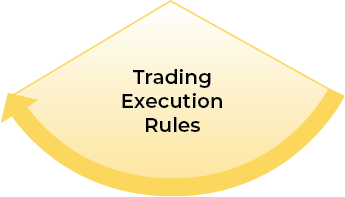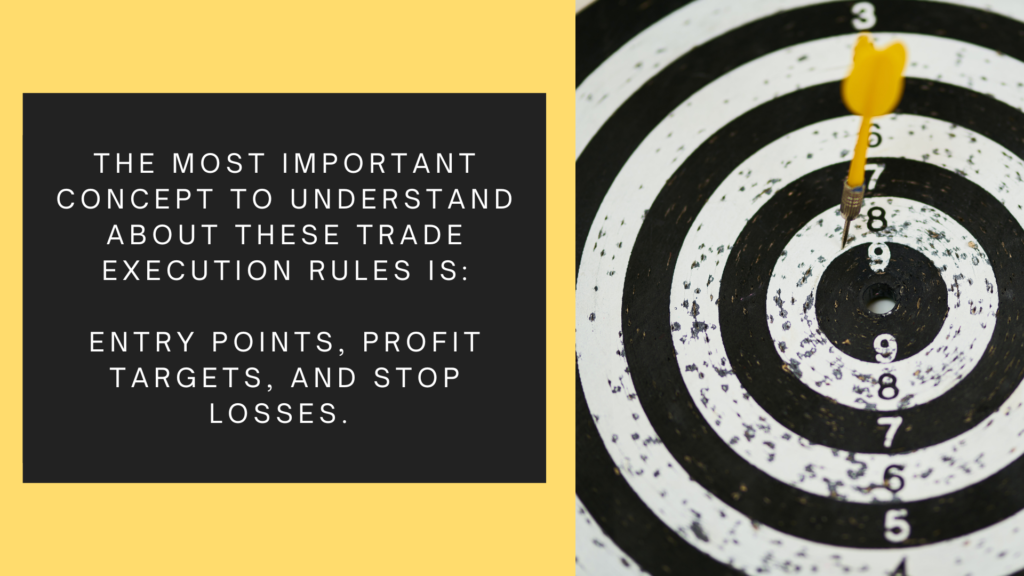Trade Execution Rules
Trade Execution Rules

This element of your trading plan is a category of specific trading rules to help you identify when to open and close your positions. These rules usually get a lot of attention from less experienced traders who focus their energy and effort on having precisely the right entry or exit for a trade. In reality entry and exit points are very flexible and can be adapted to your needs.
The most important concept to understand about these Trade Execution Rules is entry points, profit targets, and stop losses.

As you gain more experience in the markets and more confidence in your system, you may decide to adapt your entry, exit and profit target rules. In the mean time, start building your execution skills with these four rules which you should fully articulate in your trading plan:
- I will use the following sources for entries: (specify).
- I will set my exits based on the _________________ probability profile.
- I will let my trades run in the following situations: (specify).
- I will exit my position early in the following situations: (specify).
Entry and Exit rules define the day-to-day decisions a person normally makes. Most traders misunderstand what these rules are for. The next sections will help you better understand why you need to define entry and exit rules.
Trade Execution Rule 1: My Entry Methods
Your trading process may have multiple methods for entry and a specific rule or two for each method. When starting out it is useful to concentrate on a single method and hone your skills at executing that method, then adding more and moving on.
The most important concept to understand about an entry method is that its primary purpose is to provide you with the trade frequency you want. If you use an entry method that gives you high quality signals, but that signal occurs less than you need signals, say one trading idea every three months, this method would likely be insufficient for reaching your annual targeted gain.
If you want to complete 100 trades in year so that you can expect to make over 20% annual gains, you’d need to be getting 8 or more high quality signals each month. If you hope to make 100 trades in a month, you’d need a source of signals that give you 5 per day. The entry method you choose should give you enough signals for you to reach your goals.

Trade Execution Rule 2: My Exit Methods
Your system likely uses two or three methods for exiting a trade and don’t vary from these. Stick with what works. Understand exit trades play a very important role that almost all traders are completely unaware of: exits determine your winning percentage.
This idea is a big surprise to many investors and traders alike, but it is quite true and you can prove it to yourself. First set exits below (stop loss) and above (profit target) your entry point. Where you set these exits determines your winning percentage. See below:
Stop Example | Target Example | Result |
I will place a stop loss approximately 5% lower than my entry price | I will take profit after the stock has risen approximately 5% in price. | I will win 50% of my trades |
I will place a stop loss approximately 5% lower than my entry price | I will take profit after the stock has risen approximately 10% in price. | I will win 33.3% of my trades |
I will place a stop loss approximately 10% lower than my entry price | I will take profit after the stock has risen approximately 5% in price. | I will win 66.6% of my trades |
Perhaps you notice the pattern. If your profit target is closer to your entry, you will have a higher winning percentage. The tradeoff is that you will have a smaller win size. The implications of this choice will be covered further in the next lesson.
Conclusion and Homework: My Trading Plan
Approaching the market with a defined system of rules will improve your results over time. The first step towards trading systematically is to commit your trading plan to writing. Using the information found in this lesson, you can generate a trading plan.
Homework Assignments:
- Using the documents provided below, and working with your instructor, fill out a trading plan designed to fit your investing and trading objectives.
- Discuss your trading plan with your instructor.
- Put this trading plan into practice for one week using a simulated trading account.
Trading Plan Template
TRADING PLAN |
Overall Profit Objectives and Risk Tolerance |
Risk Management |
Market Analysis Filters and Rules |
Entry Signals and Rules |
Probability Profile and Exit Rules |
Evaluation |
Trading Plan Example
TRADING PLAN |
Overall Profit Objectives and Risk Tolerance |
Make more than 40% annually, drawing down no more than 20% annually |
Risk Management |
Keep trade risk at 1% for each trade with very few exceptions. |
Market Analysis Filters and Rules |
Trade three different systems designed to make money in bullish markets, but only when my markets (The S&P 500 or Nasdaq 100) are above the 200-day moving average of their ETFs (SPY and QQQ) |
Entry Signals and Rules |
Use Gap Filter and Strategy X for entries and try to place orders in the last hour of the market before it closes. |
Probability Profile and Exit Rules |
Use the Office Manager profile and set stops at 1.5 ATR, take profits at .75 ATR higher unless letting the trade run (1 in 10 trades or so). |
Evaluation Method |
Review results after each 30-trade block. Do not make rule changes within a 30-trade block. |
